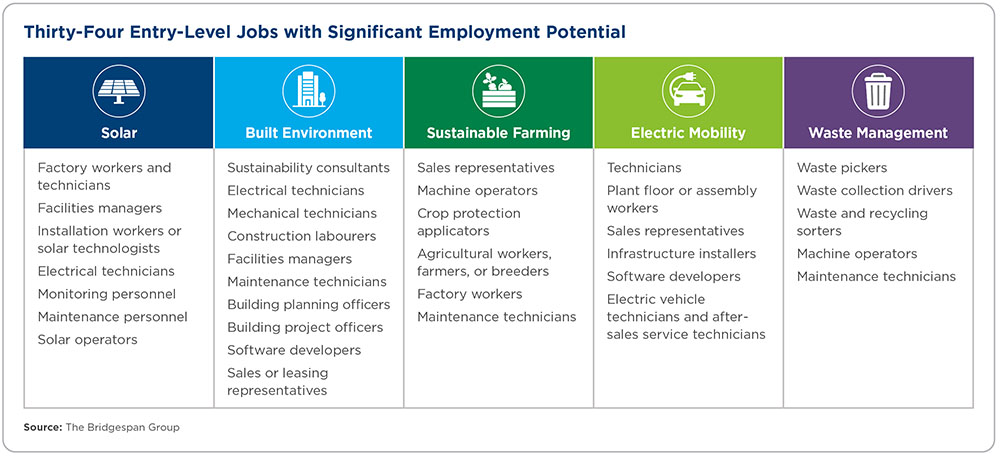Executive Summary
The transition to a green economy offers a bright future for Southeast Asia. It’s not only a US$1 trillion market opportunity by 2030 across the region’s economies.1 It’s also a pathway to a sustainable future, one that is resilient to the climate crisis, more secure for nations, healthier for residents, and inclusive for all.

This bold future, which could generate upwards of 30 million green jobs, hinges upon workforce development on an assertive scale. It will take a coordinated mix of new policies, programmes, practices, and investments to train that many workers, including those from traditionally underserved communities, and provide them access to emerging green jobs.
To guide this radical transformation, we studied employment markets across six countries—Indonesia, Malaysia, the Philippines, Singapore, Thailand, and Vietnam—and conducted 80 interviews with employers, researchers, and nongovernmental organisations (NGOs). This report, supported by J.P. Morgan, identifies steps that leaders across sectors— governments, funders, NGOs, investors, and employers—can take to ensure the emerging green economy achieves a “just transition” that leaves no one behind.
Practically speaking, that means green jobs that provide a living wage, safe working conditions, appropriate employee benefits, and equitable treatment for all workers. It also means reaching underserved individuals and communities, including those who have historically been marginalised because of their gender or rural location, for emerging green employment opportunities.
We identified 30 entry-level jobs in five sectors that are key to the green economy transition: solar, electric mobility, built environment, sustainable farming, and waste management. Some of those green jobs are in traditional sectors (e.g. manufacturing and construction) and others are in emerging green sectors (e.g. renewable energy and electric mobility). All require green-skills training and changes in business practices. Thus, the spotlight is on workforce development programmes, the organisations that deliver them, and the sectors that will benefit from them.

As ASEAN governments align their environmental sustainability plans with their workforce development policies, they can turn to examples we’ve provided of existing programmes that build the educational, training, and job-quality foundations they’ll need. This report also proposes recommendations to ensure that green jobs are accessible to underserved communities in three categories, with specific takeaways for policymakers, business leaders, investors, and NGO heads:
- Coordinate green job and skills data and definitions. Facilitate data sharing using common definitions of green jobs and skills amongst stakeholders, such as industry associations and job training organisations, and across countries in the region. This would enable leaders to focus on “hot spots” that would make the biggest difference on local and national levels.
- Improve accessibility. Bridge demand-supply gaps by connecting green job vacancies with potential employees, develop equitable hiring processes, and help individuals acquire skills to aid job placement. This includes not only specific green-skills training and job-readiness supports, but also on-ramps for underserved communities to enter the green economy.
- Improve job quality with economic benefits. Ensure green jobs pay a living wage and provide safe working conditions along with social protection benefits such as medical insurance and unemployment protection.
Only by having a workforce prepared to fill jobs that will flourish in a green economy can Southeast Asian nations achieve their commitments to carbon neutrality. They face the added challenge of ensuring green jobs are accessible to underserved individuals and communities. A just transition will lead to more equitable and sustainable economies. There’s plenty of work ahead—and no time to waste to build a green economy that works for all.
For an additional summary, see our post at Sustainable Business Magazine.





